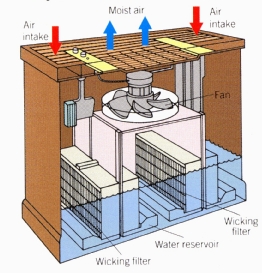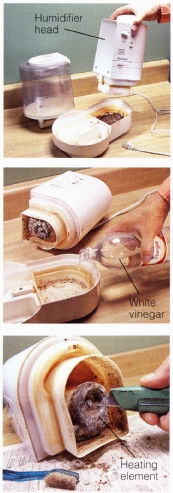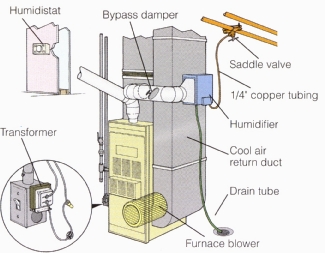AMAZON multi-meters discounts AMAZON oscilloscope discounts
Adding moisture to dry heated air in winter can ease dry throats, reduce static electricity, stabilize wood furniture and floors, and allow you to lower the thermostat a few degrees and still feel warm. Unfortunately, the process can also spew white mineral dust, molds and bacteria into the air if you are not meticulous in following the manufacturer’s instructions, although some newer units have a self-cleaning feature.

Above:
Evaporative humidifiers use filters to trap minerals in water
and to act as wicks in drawing water up to the fan, which sends moisture
into the air. Replace filters as recommended.
Tuning-up Portable Unit
Periodically, you need to remove the mineral scale that builds up on a warm-mist humidifier’s electrical heating element and in the water reservoir pan. The more fouled a heater element becomes with mineral scale, the less efficiently it vaporizes water. Clean off accumulated scale, as shown below, to keep a humidifier running efficiently. Finally, work carefully around the heating element so it doesn’t get damaged.
1. Unplug the humidifier, empty the water tank and pull off the humidifier head to reveal the reservoir pan. Empty out the water, loose mineral scale and sludge, give the pan a quick scouring and rinse it well.
2. Fill the reservoir pan with white vinegar and reinstall the humidifier head. Leave the humidifier unplugged and soak the heater element in vinegar overnight to loosen mineral scale.

3. Scrape mineral scale off the heater element using a utility knife and toothbrush. It’s not necessary to scrape it down to bare metal every where to accomplish your task.
Central Humidifiers
A central, or whole-house, humidifier offers the optimum in convenience, effectiveness and low maintenance if you need to humidify dry, winter air. Installing a central humidifier involves several skills: cutting sheet metal, electrical wiring and plumbing. This type mounts on the heating ductwork near the blower on both furnaces and heat pumps. If your home has no ductwork or is heated by hot water or electric baseboard heat, you can’t use a central humidifier.
Whenever your furnace blower switches on, the low-voltage electrical circuit that operates the humidifier also turns on. The humidifier itself operates when the humidistat, which is a moisture-sensing device mounted in a room, senses the air in your home is too dry. If you have condensation buildup on your windows, turn the humidistat lower. Check your owner’s manual for any required seasonal adjustments.
To check the humidifier’s operation, open the water- supply valve, make sure it has power and open the damper. Turn the humidistat up to high and adjust the thermostat so the furnace blower switches on. After a few minutes, you should see water coming out of the drain tube. Note: Saddle valves may not be code-com pliant in all areas.

Note: Bypass damper; Drain tube; Humidistat